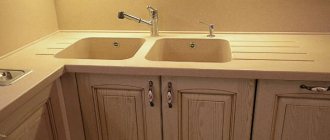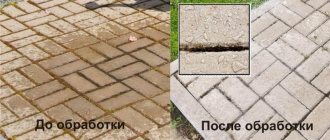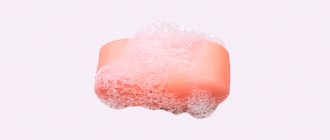A stainless steel sink needs to be properly cared for. Before purchasing a sink made from this material, you should consider whether it can be properly cared for.
Stainless steel is a strong, wear-resistant and resilient material. It is resistant to scratches, stains and other consequences of regular use. However, over time, the sink becomes covered with dark plaque, rust or lime deposits around the silicone seal and faucet.
It is important to know how to clean stainless steel sinks. After all, it’s more pleasant to wash dishes in such a sink.
Anti-blackness remedies
Blackness on stainless steel appears after 2 years. Even with proper care, the surface of the sink darkens and the shine disappears.
To care for the sink, use homemade compounds or household chemicals. You can use several products in combination to get the best effect.
How to clean a sink:
- Vinegar is an excellent cleaning agent. The universal composition saves from blackness, disinfects and whitens well. Directions for use: place a spray bottle on the bottle, spray over the surface, leave for 10 minutes. Rinse with water. Open the windows and ventilate the room.
- Starch and soda are used according to the same principle. A kitchen sponge is moistened with water and starch or soda is added. The oxidized area is cleaned with the hard side. All that remains is to wash the sink to remove any remaining product.
- Bleach works well to remove black stains on a stainless sink, but can leave white marks. Dilute with water, treat the sink, rinse with water. Clean carefully, making sure that the treated areas do not become lighter than the rest of the structure.
- Rub the problem areas with tooth powder.
Blackness is an oxidation process formed due to the negative effects of oxidizing agents. The sooner you start removing dark spots, the better they will come out.
Unfortunately, it is impossible to prevent their occurrence. It remains to use special means from time to time.
How to clean a stainless steel sink: 10 ways and 5 remedies
Last year I went to visit relatives in another city for the summer and rented out my apartment to tenants. Upon my return, an unpleasant surprise awaited me - the apartment was not cleaned. I was especially upset by the terrible condition of the new stainless steel sink.
For tips on how to clean a stainless steel sink, I turned to the Internet. I will share the information I found in this article.
You can clean a stainless steel sink with improvised means and household chemicals.
Limescale remover
Constant use of the sink requires daily maintenance. Regular contact with water leads to the formation of plaque and stains.
Limescale deposits are not deep and can be easily removed with home remedies. How to clean a sink from plaque:
- Dilute vinegar with water in a 1:1 ratio. The sink will glow like new after using this solution.
- Use a special liquid to remove limescale. For example, Ravak. Stainless steel is treated with the liquid and left to act for 10 minutes. Remove residues with plenty of water.
- Citric acid will clean your kitchen sink. Close the sink and fill with warm water. Dilute a packet of citric acid and stir until all the grains dissolve. Leave to act for 1-2 hours. Rub the walls with the hard side of the sponge, drain the waste liquid, and rinse the walls of the sink. Do not make a strong solution of citric acid; dark spots will appear on the sink.
- Distribute baking soda evenly. Rub thoroughly, rinse and repeat.
- Use Astonish paste to clean pots and ovens. This is a soft abrasive and will not damage the surface. Apply to the sink, rub well with a sponge, and rinse.
- Apply oxalic acid in powder form. Dilute the powder with water. Treat the water stone with gruel. After 15 minutes, wash off the residue.
- Dry mustard gives a good effect. Cover problem areas with powder, wash thoroughly with a sponge, and rinse off the residue with water. Mustard cleans the pipeline well if there is an unpleasant odor. Not suitable for plastic pipes.
The only methods to prevent limescale deposits are to check the taps for leaks and wipe the sink dry after use. Avoid constant presence of water in the sink.
Add shine
The matte film is effectively removed:
- Vinegar 9%. It is applied to the surface of the sink, previously cleaned of stains, and washed off after 20-30 minutes with running water. You can also line the sink bowl with a cloth soaked in vinegar.
- Lemon juice. To make the sink shine, it is treated with a solution (1 tablespoon per 200 ml of water) or pure juice applied to a cloth.
- Ammonia. It is used only in the form of a weak warm solution (5 drops per 1 liter of water). After treatment, it is necessary to rinse the sink with plenty of water.
When working with aggressive substances (vinegar, ammonia and GOI paste), you must wear rubber gloves and open the window.
Removing dirt and greasy deposits
To remove greasy deposits, use regular dishwashing detergent. Laundry soap will do.
A cleaning agent made from soda and office glue will help clean the sink. How to clean a stainless steel sink:
- Boil 5 liters of water, add 100 g. soda and 100 ml of transparent stationery glue.
- Wait for dissolution. Close the sink and pour the prepared solution into it.
- When the mixture has cooled down, drain it.
- All dirt will come off. All you have to do is wash the sink with clean water.
This method is used to clean stainless cookware. It is boiled for 20 minutes, left to cool and rinsed with water.
Intensive cleaning
To remove stubborn dirt or salt deposits, fill the sink with hot water and add 50 ml of cleaning solution - you can use dishwashing liquid or tablets intended for dishwashers. The advantage of tablets is that they dissolve quickly and the liquid penetrates into hard-to-reach areas. After this procedure, the dirt will begin to come off; you will need to remove it with a large sponge. Particular attention should be paid to hard-to-reach areas.
Old dirt can be washed off with soda. To remove the salt deposits faster, you need to pour a solution based on salt and soda into the sink and let it sit for 15 minutes. It will also eliminate old fat.
To give the sink a shine, after completing the cleaning procedures, you need to treat it with vinegar.
The product has a disinfecting effect; its remains are removed with a damp cloth. After treating the sink surface, clean the drain. To do this, pour 100 g of soda into the pipe and pour in the same amount of vinegar. A chemical reaction occurs that causes foaming, resulting in the dissolution of fat and plaque.
To remove soda particles, pour 5 liters of hot boiled water into the sink. It is important to eliminate dirt that has accumulated in raised areas and the pipeline. To do this, pour a lot of crushed ice and 2 times less salt into the sink, then turn on the water. This procedure allows you to remove even old plaque.
Please like and subscribe to the
LifeHackney .
This will allow us to publish more interesting articles. Source
How to get rid of unpleasant odor
Cleaning a stainless steel sink is not enough to remove the stink. It can be eliminated using special compounds or folk remedies.
How to get rid of the smell:
- Pour salt into the drain hole. Leave for an hour. Rinse with water.
- Pour the required amount of Mole into the drain. To fill with water. Leave the composition to act for 5–10 minutes. Rinse the drain hole well.
- Spray the sink with baking soda and pour it into the drain. Then pour in vinegar, preferably from a spray bottle. Pour into the drain hole too. A reaction will begin, during which foam and hissing will appear. After 10 minutes, pour boiling water into the drain hole and rinse the sink itself with warm water.
- Pour Domestos or Deboshir into the drain. Leave for 2 hours. Rinse the drain with plenty of water. Domestos can be used to clean the sink. Will clean off any dirt.
When purchasing professional chemicals, pay attention to the composition. If the drain in the house is made of plastic pipes, the Israeli product Pothan will do.
How to care for a stainless kitchen sink?
The unique properties of high-quality stainless steel make it the optimal material for the manufacture of sanitary ware and kitchen sinks. Thanks to the presence of a protective anti-corrosion layer, rust does not occur on kitchen sinks, and due to the lack of porosity, stubborn stubborn stains do not appear.
Modern stainless steel kitchen sinks are practical and durable, and they fit perfectly with almost any kitchen furniture - both classic and ultra-modern.
However, stainless steel kitchen sinks also require regular maintenance. Proper care is necessary, firstly, for the hygiene and aesthetics of the sink, and secondly, for its long service life. Stainless steel sinks, sold wholesale and retail in our country, are mostly made of high-strength steel that has undergone special protective treatment. They are resistant to contamination and bacterial formation. However, without proper care, even the highest quality stainless sink will lose its original appearance.
Rules of care
Caring for a stainless sink is simple and easy. The main thing is to follow the rules and not use prohibited cleaning methods.
How to care:
- Select cleaning and detergent products carefully. Stainless steel is easily damaged by acids and alkalis. Study the composition more carefully.
- Do not use steel jaws. This is the main enemy. The iron sponge leaves scratches on the surface. Bacteria penetrate into them, and the sink rusts faster (if it is made of poor-quality stainless steel).
- Remains of food remaining on the strainer should be removed immediately.
- Rinse with warm water after each use.
- In the evening, wipe with a dry cloth, preferably after each wash.
- Regular cleaning is important for stainless steel sinks. Wash once a day with detergent. This will prevent the accumulation of grease and dirt that lead to dark spots on the surface.
- Do not allow rusty objects to fall into the bottom of the sink. Nuts, nails or wire wool will cause rust stains.
- Do not use sharp objects to remove dirt. For example, sandpaper, knife, file.
The advantage of a stainless steel sink is that there are no stains of wine, coffee, tea or juice left on the surface.
If you properly care for your stainless sink, install a water filter and do not use prohibited cleaning products, your sink will look attractive for a long time.
Stainless steel is a good, hygienic material, wear-resistant and reliable. A sink made of this material will not warp if hot oil is poured into it and will not change color.
To ensure that the sink does not lose its functional and aesthetic benefits, it must be properly and regularly maintained.
Why choose stainless steel?
How to choose the right sink? In today's market, sinks made of material that does not rust are relevant.
The main advantages when choosing such a stainless steel kitchen item are:
- Low price.
- The service life is quite long.
- Durable, withstands heavy loads.
- Resistant to high temperatures.
- It does not contain harmful metals.
To ensure that your sink always looks like new, you need to keep it clean. Don’t forget to remove all kinds of dirt from it. Every housewife should remember that cleaning the dish sink should be done regularly. Daily contact with water affects the condition of the coating.
Types of sinks by installation method
In the kitchen you can find different types of sinks. They are usually divided according to the method of equipment and there are three varieties that have certain characteristics.
- Overhead sinks are “slipped” onto a floor cabinet. This type serves not only as a sink, but also as a countertop. Housewives do not have to worry about sizes, since manufacturers make small, medium and large sinks. To install a sink, you don’t have to call a professional, because the overhead type is very easy to install with your own hands. But it is worth noting that this type has one drawback - subtlety. Because of this negative point, the countertop sink may be subject to various defects and will last less than other types.
- The built-in sink is easily installed on the countertop. This type is becoming more popular every day. When installing the sink, no seams or cracks will form, which automatically prevents liquid accumulation.
- The integrated sink has a different structure of sides, i.e. 2 or 3 sinks are connected into a common façade. But this type is difficult to install yourself, so it is better to call a specialist. It will also require a special mixer that can easily make various turns. This type of sink should be installed just below the level of the countertop.











